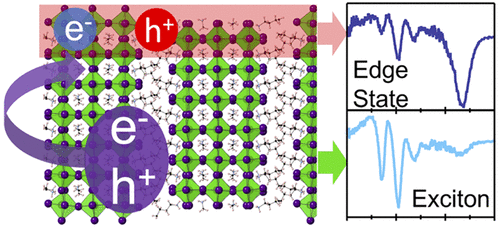当前位置:
X-MOL 学术
›
ACS Mater. Lett.
›
论文详情
Our official English website, www.x-mol.net, welcomes your
feedback! (Note: you will need to create a separate account there.)
Edge States Drive Exciton Dissociation in Ruddlesden–Popper Lead Halide Perovskite Thin Films
ACS Materials Letters ( IF 9.6 ) Pub Date : 2020-09-15 , DOI: 10.1021/acsmaterialslett.0c00333 Eli D. Kinigstein 1, 2 , Hsinhan Tsai 3 , Wanyi Nie 3 , Jean-Christophe Blancon 4 , Kevin G. Yager 2 , Kannatassen Appavoo 5 , Jacky Even 6 , Mercouri G. Kanatzidis 7 , Aditya D. Mohite 4 , Matthew Y. Sfeir 2, 8, 9
ACS Materials Letters ( IF 9.6 ) Pub Date : 2020-09-15 , DOI: 10.1021/acsmaterialslett.0c00333 Eli D. Kinigstein 1, 2 , Hsinhan Tsai 3 , Wanyi Nie 3 , Jean-Christophe Blancon 4 , Kevin G. Yager 2 , Kannatassen Appavoo 5 , Jacky Even 6 , Mercouri G. Kanatzidis 7 , Aditya D. Mohite 4 , Matthew Y. Sfeir 2, 8, 9
Affiliation

|
Efficient photovoltaic cells based on thin films of solution-processed 2D Ruddlesden–Popper hybrid perovskites (RPPs) represent an exciting breakthrough due to their enhanced tunability and chemical stability relative to those fabricated from 3D phases. However, reports of efficient charge separation and current collection are in apparent contradiction with the well-known enhancement of the exciton binding energy in multilayered halide perovskites, which should lower the device’s internal quantum efficiency and voltage. This controversy has led to various proposals for the electronic and physical structure of RPP thin films, including phase inhomogeneity as the driving force for exciton dissociation and transport. We address this apparent paradox in high-quality hot-cast RPP films by correlating ultrafast transient absorption spectroscopy with X-ray scattering measurements. We show that a hot-casting fabrication method produces highly phase pure n = 3 (BA)2(MA)n−1PbnI3n+1 RPP structures. The high-phase purity and large grain sizes allow us to observe vertical transport of excitons via a diffusive process and allow us to determine that charge separation is primarily driven by dissociation at surface localized subgap electronic states. We analyze the differential absorption kinetics in films of varying thickness to directly determine that the excitonic diffusion constant is ∼0.18 cm2 s–1. We propose that a surface localized structural distortion, observed using surface selective grazing incidence X-ray scattering measurements, is responsible for the creation of the surface localized defect states. We find that the density and spatial distribution of these defect states is a function of preparation conditions.
中文翻译:

边缘状态驱动Ruddlesden–Pop卤化铅钙钛矿薄膜中的激子离解。
基于溶液处理的2D Ruddlesden-Popper混合钙钛矿(RPP)薄膜的高效光伏电池由于其增强的可调性和化学稳定性(相对于3D相制造)具有令人兴奋的突破。但是,关于电荷有效分离和电流收集的报道与多层卤化物钙钛矿中激子结合能的众所周知的增强明显矛盾,后者会降低器件的内部量子效率和电压。这场争论引发了有关RPP薄膜的电子和物理结构的各种提议,包括相不均匀性作为激子解离和传输的驱动力。通过将超快速瞬态吸收光谱与X射线散射测量相关联,我们解决了高质量热浇铸RPP薄膜中的这一明显悖论。我们表明,热铸制造方法可产生高相纯n = 3(BA)2(MA)n -1 Pb n I 3 n +1 RPP结构。高相纯度和大晶粒尺寸使我们能够通过扩散过程观察激子的垂直传输,并使我们能够确定电荷分离主要是由表面局部亚能级电子态的解离驱动的。我们分析了不同厚度薄膜的吸收动力学差异,以直接确定激子扩散常数为〜0.18 cm 2 s –1。我们提出,使用表面选择性掠入射X射线散射测量观察到的表面局部结构变形是造成表面局部缺陷状态的原因。我们发现这些缺陷状态的密度和空间分布是制备条件的函数。
更新日期:2020-10-05
中文翻译:

边缘状态驱动Ruddlesden–Pop卤化铅钙钛矿薄膜中的激子离解。
基于溶液处理的2D Ruddlesden-Popper混合钙钛矿(RPP)薄膜的高效光伏电池由于其增强的可调性和化学稳定性(相对于3D相制造)具有令人兴奋的突破。但是,关于电荷有效分离和电流收集的报道与多层卤化物钙钛矿中激子结合能的众所周知的增强明显矛盾,后者会降低器件的内部量子效率和电压。这场争论引发了有关RPP薄膜的电子和物理结构的各种提议,包括相不均匀性作为激子解离和传输的驱动力。通过将超快速瞬态吸收光谱与X射线散射测量相关联,我们解决了高质量热浇铸RPP薄膜中的这一明显悖论。我们表明,热铸制造方法可产生高相纯n = 3(BA)2(MA)n -1 Pb n I 3 n +1 RPP结构。高相纯度和大晶粒尺寸使我们能够通过扩散过程观察激子的垂直传输,并使我们能够确定电荷分离主要是由表面局部亚能级电子态的解离驱动的。我们分析了不同厚度薄膜的吸收动力学差异,以直接确定激子扩散常数为〜0.18 cm 2 s –1。我们提出,使用表面选择性掠入射X射线散射测量观察到的表面局部结构变形是造成表面局部缺陷状态的原因。我们发现这些缺陷状态的密度和空间分布是制备条件的函数。











































 京公网安备 11010802027423号
京公网安备 11010802027423号